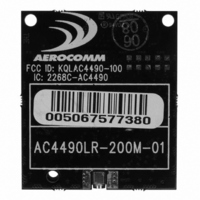AC4490LR-200M Laird Technologies, AC4490LR-200M Datasheet - Page 65

AC4490LR-200M
Manufacturer Part Number
AC4490LR-200M
Description
TXRX 900MHZ 3.3-5.5V TTL 200MW
Manufacturer
Laird Technologies
Series
AeroCommr
Specifications of AC4490LR-200M
Frequency
902MHz ~ 928MHz
Data Rate - Maximum
115.2kbps
Modulation Or Protocol
FHSS, FSK
Applications
AMR, Fire & Security Alarms, Telemetry
Power - Output
5mW ~ 200mW
Sensitivity
-110dBm
Voltage - Supply
3.3V, 5V
Current - Transmitting
68mA
Data Interface
Connector, 2 x 10 Header
Antenna Connector
MMCX
Operating Temperature
-40°C ~ 85°C
Package / Case
Module
Output Power
200 mW
Lead Free Status / RoHS Status
Contains lead / RoHS non-compliant
Memory Size
-
Current - Receiving
-
Lead Free Status / Rohs Status
Lead free / RoHS Compliant
A
S Y N C T O C H A N N E L
W h a t i s i t a n d d o I n e e d i t ?
AeroComm uses frequency hopping protocol with a fixed pseudo-random hopping sequence on our transceivers.
This protocol yields superior interference rejection and multipath immunity. The Server radio sends timing beacons
out on a regular interval and the Clients hear these beacons and synchronize their frequency hopping to the Server.
Though Servers cannot send packets to each other, they can hear the timing beacons sent out by other Servers.
Normally, they simply ignore the beacons sent out by the other Servers. However, when Sync-to-Channel is enabled,
they will listen for the beacons sent out by another Server and then synchronize their hop timing to that Server.
Why is this important? If two Servers (and their Clients) are operating in the same area and their frequency hopping is
not synchronized to each other it's possible that they might try to occupy the same frequency at the same time. In
severe cases, they could interfere with each other on every frequency, causing very sluggish communications.
To avoid this kind of interference, collocated Servers can use Sync-to-Channel. Sync-to-Channel synchronizes the
frequency hop timing between these Servers so that they never occupy the same frequency at the same time.
To use Sync-to-Channel, you should select one Server (preferably the most centrally located Server) to be the "Hop
Master." This Server should be programmed to a numerically low Channel Number and should have Sync-to-Channel
disabled. All other Servers in the area should have Sync-to-Channel enabled. These other Servers should have Sync-
Channel set to the Channel of another Server in the area that they are in range of. Preferably, if all Servers are in
range of the Hop Master, they should all have their Sync-Channel set to the Channel Number of the Hop Master. The
following rules apply to Sync-to-Channel:
One Server should perform the function of Hop Master. It should have its Channel Number set to a numerically low
value and should have Sync-to-Channel disabled. It's preferable that it be centrally located. All other Servers in the
area should have Sync-to-Channel enabled. They should have their Sync-Channel set to a value lower than their
Channel Number. If they are in range of the Hop Master, its preferable that they have the Sync-Channel set to the
Channel Number of the Hop Master.
All collocated Servers must be programmed to the same Channel Set. There are 56 available channels for the
AC4490, shown in Table 19 below.
PPENDIX
0 (AC4490 - 1x1
1 (AC4490 - 1x1
2 (AC4490 - 1x1
AC4490 - 200
AC4490 - 200)
1. All collocated Servers must operate in the same Channel Set.
AC4490 - 1000)
AC4490 - 1000)
Channel Set
IV - S
1
YNC TO
0x00 - 0x0F
0x10 - 0x2F
0x30 - 0x37
Number Range
Table 20: RF Channels for AC4490
RF Channel
(0x40)
www.aerocomm.com
C
HANNEL
902 - 928 MHz (26 hop bins)
902 - 928 MHz (50 hop bins)
915 - 928 MHz (22 hop bins)
Regulatory requirements
Frequency Details &
US / Canada
US / Canada
US / Canada (-1x1 / -200)
Australia(-1x1/-200/-1000)
Countries
IV

















